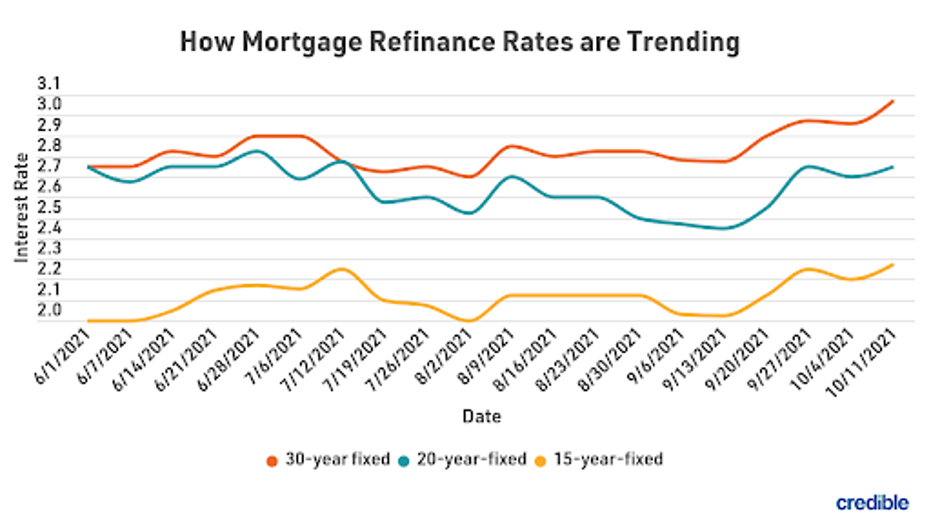Mortgage refinance rates hold: Refinance now ahead of predicted increases | Oct. 21, 2021
Higher than last week and this time last month, mortgage refinance rates are heading north.

Check out the mortgage refinancing rates for Oct. 21, 2021, which are unchanged from yesterday. (iStock)
Based on data compiled by Credible, current mortgage refinance rates have remained unchanged compared to yesterday.
- 30-year fixed-rate refinance: 3.125%, unchanged
- 20-year fixed-rate refinance: 2.750%, unchanged
- 15-year fixed-rate refinance: 2.375%, unchanged
- 10-year fixed-rate refinance: 2.375%, unchanged
Rates last updated on Oct. 21, 2021. These rates are based on the assumptions shown here. Actual rates may vary.
Mortgage refinance rates across all terms haven’t changed since yesterday, though mortgage experts have predicted that rates could rise further by the end of the year. Rates for a 20-year term continue to stand out as a bargain for homeowners looking to refinance and save on interest while keeping their monthly payments manageable. This term has held firmly at 2.750% for 12 straight days. Overall, refinance rates are higher today than they were last week at this time and last month at this time.
If you’re thinking of refinancing your home mortgage, consider using Credible. Whether you're interested in saving money on your monthly mortgage payments or considering a cash-out refinance, Credible's free online tool will let you compare rates from multiple mortgage lenders. You can see prequalified rates in as little as three minutes.
Current 30-year fixed refinance rates
The current rate for a 30-year fixed-rate refinance is 3.125%. This is the same as yesterday. Refinancing a 30-year mortgage into a new 30-year mortgage could lower your interest rate, but may not have much effect on your total interest costs or monthly payment. Refinancing a shorter term mortgage into a 30-year refinance could result in a lower monthly payment but higher total interest costs.
Current 20-year fixed refinance rates
The current rate for a 20-year fixed-rate refinance is 2.750%. This is the same as yesterday. By refinancing a 30-year loan into a 20-year refinance, you could secure a lower interest rate and reduced total interest costs over the life of your mortgage. But you may get a higher monthly payment.
Current 15-year fixed refinance rates
The current rate for a 15-year fixed-rate refinance is 2.375%. This is the same as yesterday. A 15-year refinance could be a good choice for homeowners looking to strike a balance between lowering interest costs and retaining a manageable monthly payment.
Current 10-year fixed refinance rates
The current rate for a 10-year fixed-rate refinance is 2.375%. This is the same as yesterday. A 10-year refinance will help you pay off your mortgage sooner and maximize your interest savings. But you could also end up with a bigger monthly mortgage payment.
You can explore your mortgage refinance options in minutes by visiting Credible to compare rates and lenders. Check out Credible and get prequalified today.
Rates last updated on Oct. 21, 2021. These rates are based on the assumptions shown here. Actual rates may vary.

These rates are based on the assumptions shown here. Actual rates may vary.
If you think refinancing is the right move, consider using Credible. You can use Credible's free online tool to easily compare multiple mortgage refinance lenders and see prequalified rates in as little as three minutes.
Rates last updated on Oct. 21, 2021. These rates are based on the assumptions shown here. Actual rates may vary.
What are the different types of refinancing?
Refinancing your mortgage basically means you take out a new mortgage to pay off your current home loan. But your reasons for wanting to refinance can affect the type of mortgage refinance you choose.
Here are four types of refinancing to consider.
Rate and term refinance
This type of refinance is probably what many people think of when they consider refinancing their mortgages. As the name implies, a rate and term refinance changes the rate, repayment period — or both — of your current mortgage by paying it off and replacing it with a new mortgage. With a rate and term refinance, you would borrow exactly the amount you need to pay off your current mortgage.
Cash-out refinance
Like a rate and term refinance, a cash-out refinance may change the rate, term or both. But with this type of refinance, you borrow more than you need to pay off your current loan and take that balance as cash. This is only possible if you have sufficient equity built up in your home.
Cash-in refinance
As with other types of refinancing, a cash-in refinance replaces your current mortgage with one that has a different interest rate and/or term. But for your new loan, you’ll also make a lump sum payment to reduce the principal balance on your new mortgage. Of course, if you have the money to make a lump sum payment, you could just pay extra toward the principal on your current loan. But making this payment in connection with a refinance allows you to reap the interest savings that can come with refinancing.
FHA streamline refinance
This type of refinancing is only available for people who have FHA mortgages. It offers the same basic benefits as other types of refinancing but requires less paperwork. Some limitations apply. For example, you can’t be behind on your current mortgage, and you can’t cash out more than $500.
How to get your lowest mortgage refinance rate
If you’re interested in refinancing your mortgage, improving your credit score and paying down any other debt could secure you a lower rate. It’s also a good idea to compare rates from different lenders if you're hoping to refinance, so you can find the best rate for your situation.
Borrowers can save $1,500 on average over the life of their loan by shopping for just one additional rate quote, and an average of $3,000 by comparing five rate quotes, according to research from Freddie Mac.
Be sure to shop around and compare rates from multiple mortgage lenders if you decide to refinance your mortgage. You can do this easily with Credible’s free online tool and see your prequalified rates in only three minutes.
How does Credible calculate refinance rates?
Changing economic conditions, central bank policy decisions, investor sentiment and other factors influence the movement of mortgage refinance rates. Credible average mortgage refinance rates are calculated based on information provided by partner lenders who pay compensation to Credible.
The rates assume a borrower has a 740 credit score and is borrowing a conventional loan for a single-family home that will be their primary residence. The rates also assume no (or very low) discount points and a down payment of 20%.
Credible mortgage refinance rates will only give you an idea of current average rates. The rate you receive can vary based on a number of factors.
How to find the best refinance rate
Some factors that affect the refinance rate you’ll get are out of your control. But you can take several steps to ensure you secure the best refinance rate available to you. Here are some to consider.
Save for closing costs
You may be aware that it’s a good idea to save for a down payment when you’re first buying a house. Even though you can get a loan with little or no down payment, having at least a 20% down payment affords numerous advantages — including the ability to avoid PMI.
But it’s also a good idea to save up for closing costs, which — according to Freddie Mac — can average $5,000.
Polish your credit
Just as when you bought your home, your credit score and history affect your refinance rate, so it’s a good idea to make sure your credit is in the best possible shape.
Check your credit report for any errors, such as incorrect information of duplicated accounts. Pay off as much other debt as you can to improve your debt-to-income ratio. And pay down credit card balances to reduce your credit utilization.
Comparison shop
Just as you would compare quotes from multiple vendors for an expensive home repair, you should look at loans and mortgage interest rates from multiple lenders. Each lender has its own methods for setting interest rates, so shopping around could help you find the lowest rate available to you.
In fact, getting five rate quotes could save you $3,000 over the life of your mortgage, according to a Freddie Mac survey.
Credible is also partnered with a home insurance broker. If you're looking for a better rate on home insurance and are considering switching providers, consider using an online broker. You can compare quotes from top-rated insurance carriers in your area — it's fast, easy and the whole process can be completed entirely online.
Have a finance-related question, but don't know who to ask? Email The Credible Money Expert at moneyexpert@credible.com and your question might be answered by Credible in our Money Expert column.
As a Credible authority on mortgages and personal finance, Chris Jennings has covered topics that include mortgage loans, mortgage refinancing, and more. He’s been an editor and editorial assistant in the online personal finance space for four years. His work has been featured by MSN, AOL, Yahoo Finance, and more.
